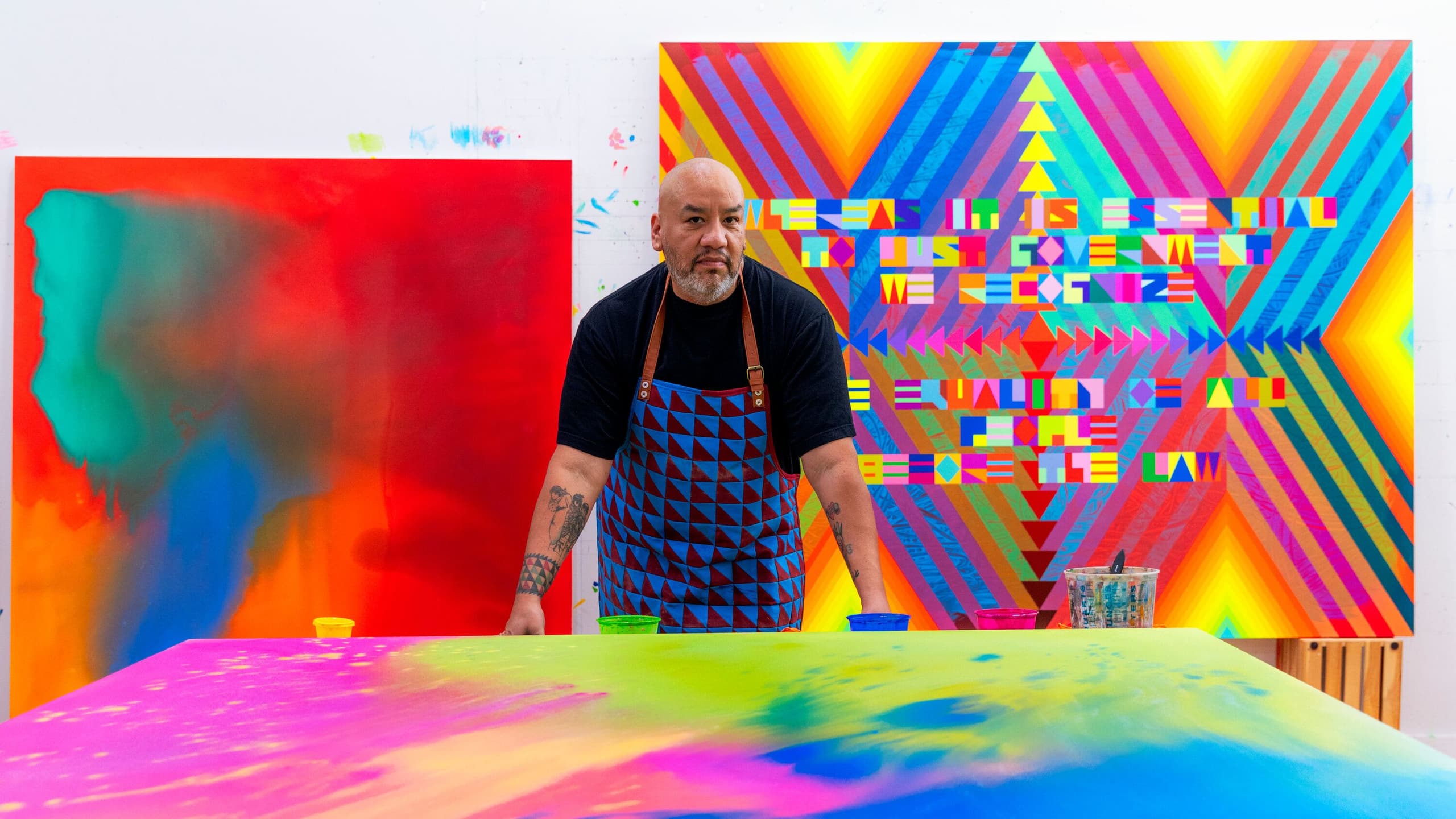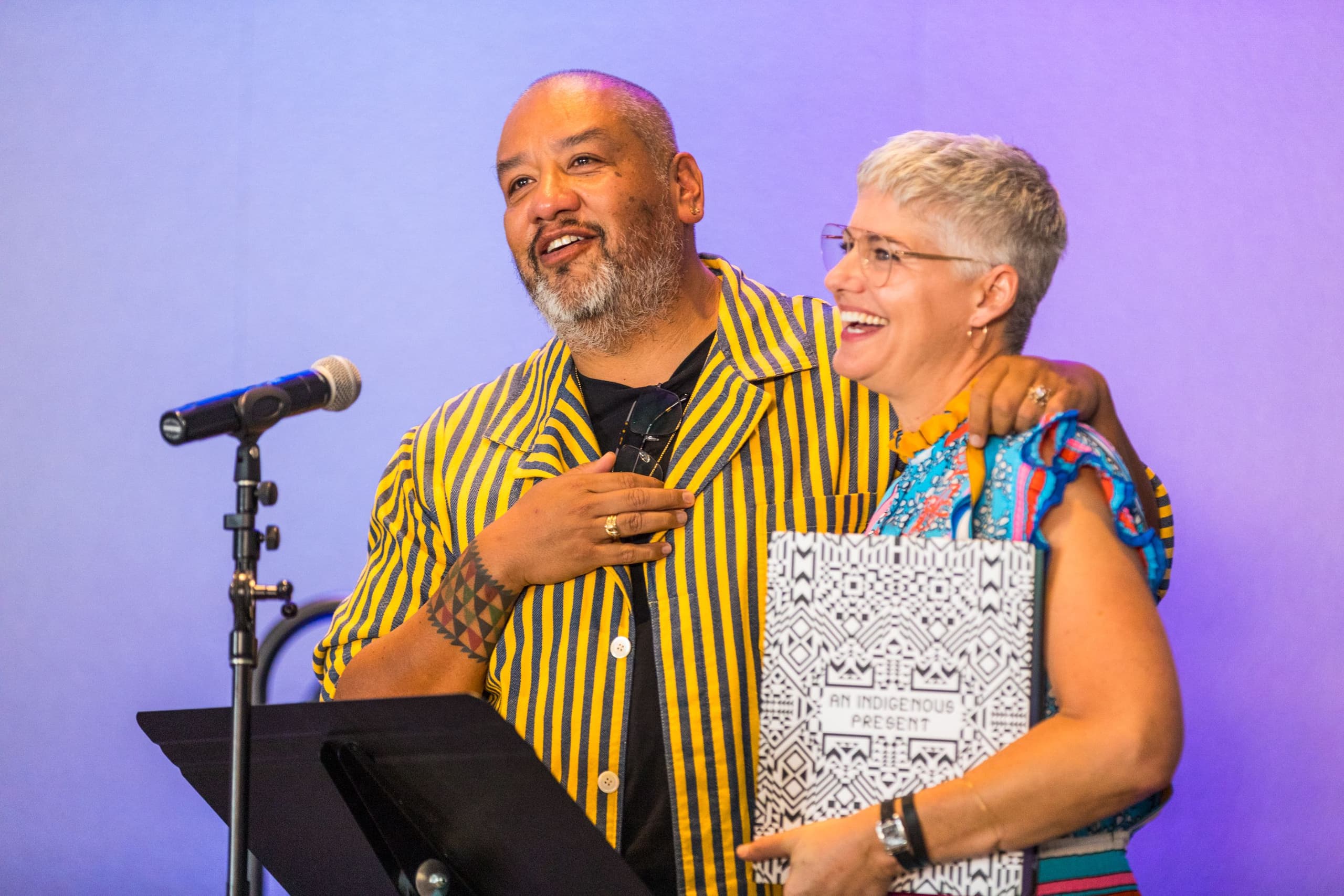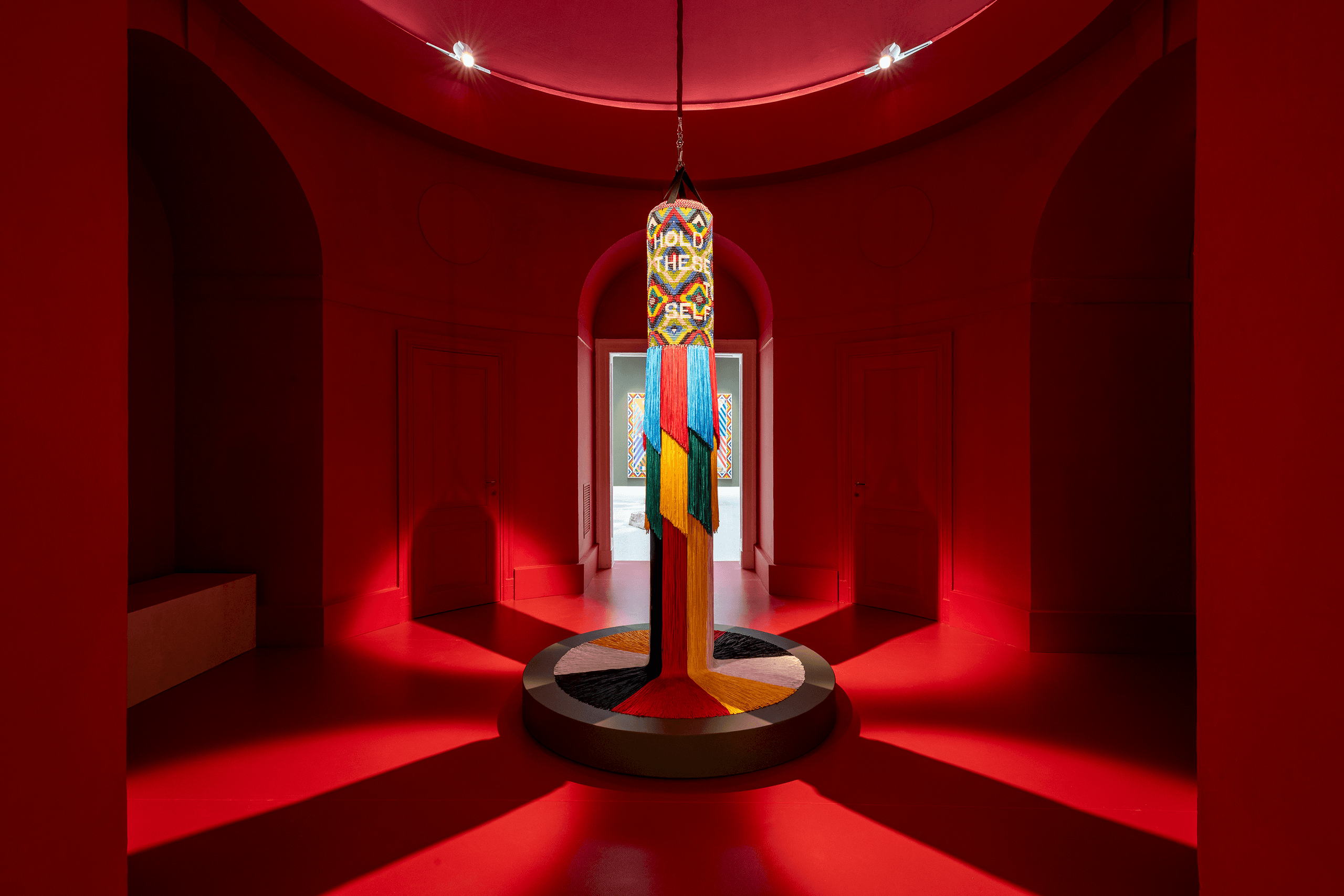60TH INTERNATIONAL ART EXHIBITION OF LA BIENNALE DI VENEZIA
Jeffrey Gibson
the space in which to place me
On view at the U.S. Pavilion from April 20 through November 24, 2024
Co-commissioned by SITE SANTA FE and Portland Art Museum in cooperation with the U.S. Department of State’s Bureau of Educational and Cultural Affairs
60th International Art Exhibition of La Biennale di Venezia
Jeffrey Gibson represents the United States
Jeffrey Gibson is the first Indigenous artist to represent the U.S. with a solo exhibition. His exhibition is also the first to be commissioned and co-curated by a Native American curator.
Entitled the space in which to place me in reference to Layli Long Soldier’s poem Ȟe Sápa, this exhibition is the first major showing of Gibson’s work outside of the U.S.
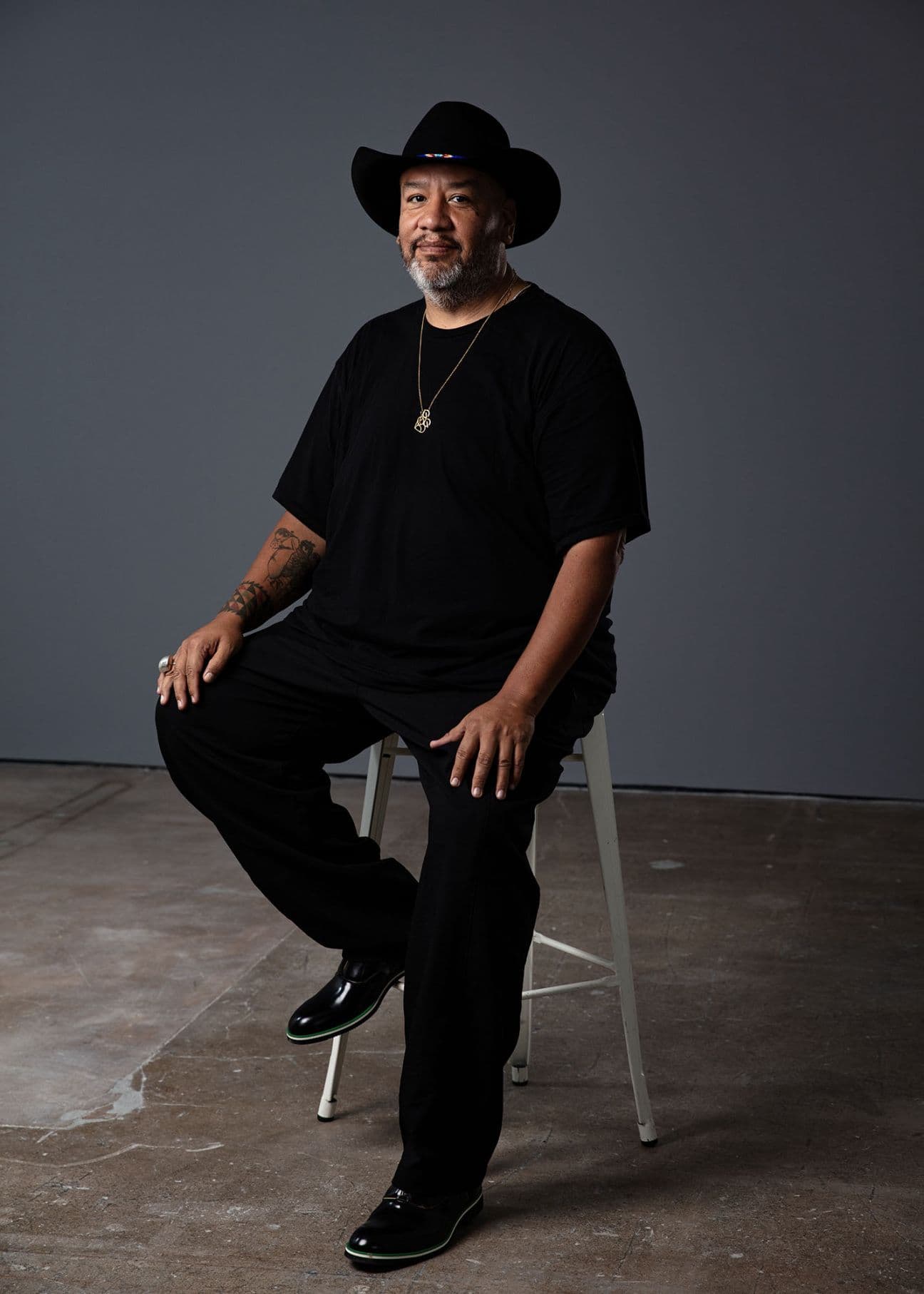
About Jeffrey Gibson

Written by Kathleen Ash-Milby and Abigail Winograd
About the Exhibition
the space in which to place me is a kaleidoscopic synthesis of the media and concepts that define Jeffrey Gibson's multidimensional practice.1
His persistent pursuit of beauty celebrates individuals and communities who have maintained their dignity and traditions in impossible circumstances. Acknowledging that our present and future are interwoven with our past, Gibson's work reflects his admiration and respect for the generations of Indigenous makers who have come before him.
His site-responsive installation for the U.S. Pavilion recognizes Indigenous aesthetics and material histories as effective tools for cultural survival, innovation, and healing from the impacts of historical trauma. the space in which to place me joyously declares Gibson's radically inclusive vision for a future in which all people are seen, accepted, and loved.
1 The title of the exhibition is an excerpt from Oglala Lakota poet Layli Long Soldier's “Ȟe Sápa,” part three, published in Whereas (Minneapolis: Graywolf, 2017). It is used with the permission of the artist.

His provocation in Venice begins by swathing the building in hand-painted murals with his signature riot of color, pattern, and text.
Throughout his career, Gibson has defied modernist orthodoxies, challenging us to see the world differently through his unapologetic indulgence in color and unabashed use of materials associated with (and denigrated as) craft. A monumental outdoor sculpture, an amalgamation of classical pedestals, sets the stage for exchange and catharsis, transforming the pavilion's forecourt into a gathering place that monumentalizes peoples and stories that have been historically ignored.
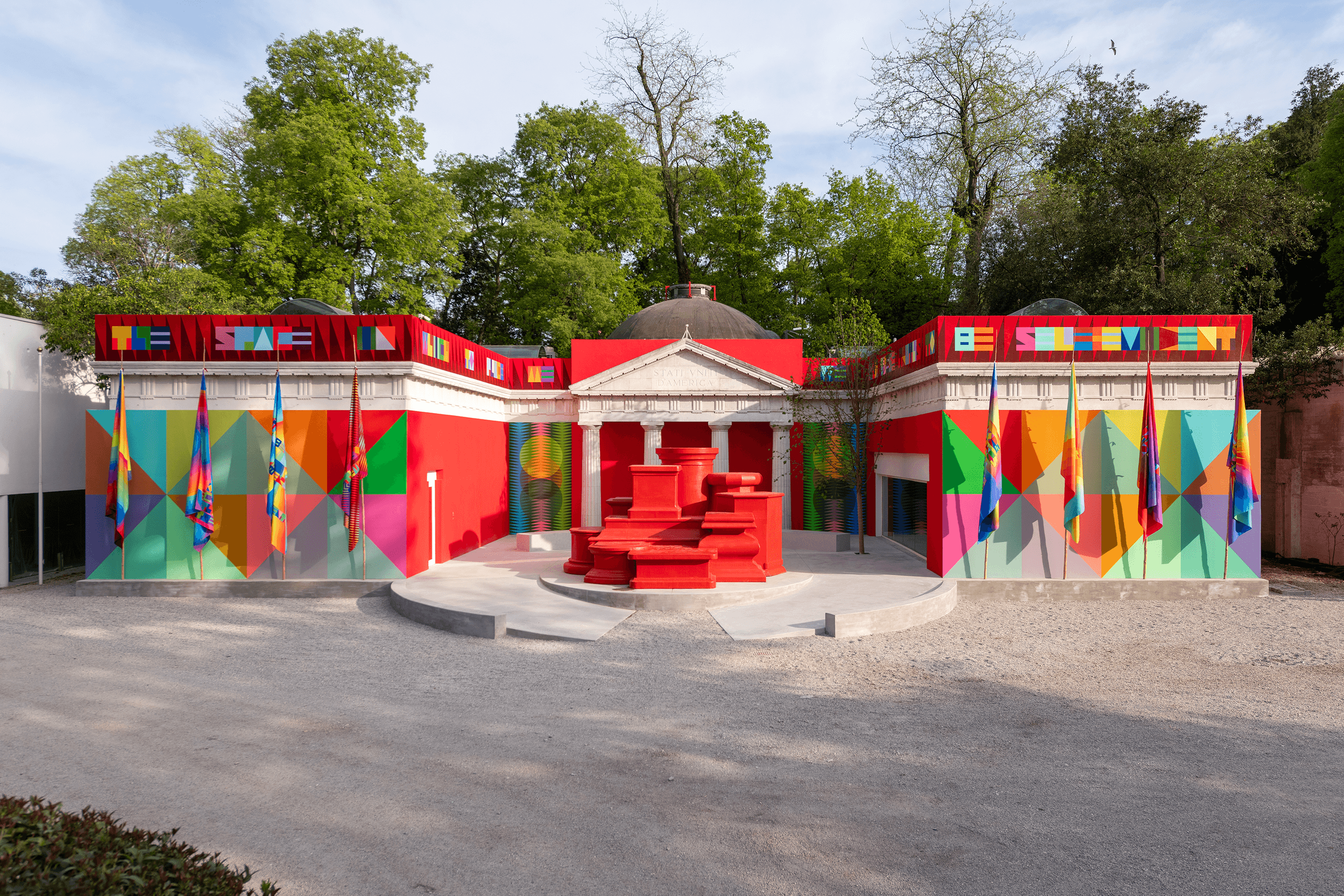
Gibson's evocations of ancestral spirits, titled The Enforcer and WE WANT TO BE FREE, greet visitors to the exhibition.
The towering figures' glazed-ceramic heads recall Mississippian effigy pots, an ancient tradition from the American Southeast, where Gibson's Choctaw and Cherokee forebears originated. WE WANT TO BE FREE references text from the Indian Citizenship Act, a 1924 law granting Indigenous people in the United States basic rights; and the Civil Rights Act of 1866, which defines the privileges of U.S. citizenship and affords all citizens equal protection under the law.
The Enforcer's cloak refers to both the Reconstruction Amendments and Reconstruction Acts (1865–70) that together sought to protect the rights of Black citizens after the abolition of slavery, and the Enforcement Act of 1870, which penalizes interference with a person's right to vote. Witnesses and guardians, these looming figures stand in front of a mural that borrows the phrase “we are made by history” from a 1954 speech by Martin Luther King Jr., who exhorted his congregation to forge their futures actively rather than passively to allow the forces of history to shape their lives.2 The installation is Gibson's rejoinder, pointing to specific historical moments as he probes the distance between the ideals of American democracy and its enactment in reality.
2 For links to the text source documents, see Checklist and Resources.
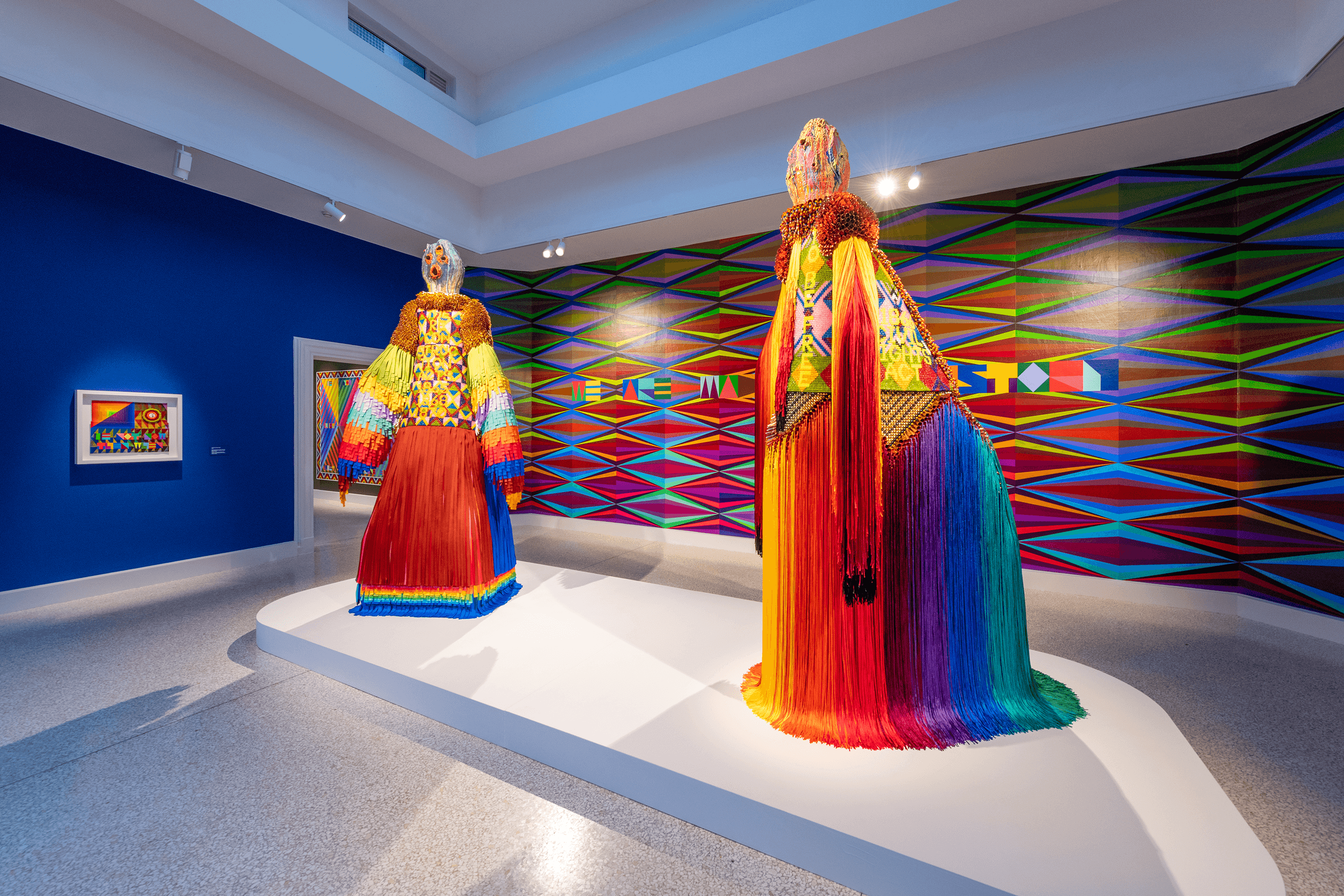
Jeffrey Gibson: the space in which to place me installed in the U.S. Pavilion of the Venice Biennale, 2024, photos by Timothy Schenck; All artwork courtesy of Jeffrey Gibson Studio
Across the exhibition, Gibson juxtaposes a variety of texts, drawing on sources ranging from poetry to song lyrics to excerpts from legislative documents.
This blending of pop culture with foundational federal records continues his efforts to blur the boundaries between kitsch and fine art, high and low culture. These efforts situate his work within art histories that have previously excluded Native artists, and in the footsteps of postwar painters such as Jaune Quick-to-See Smith, Corita Kent, Jean-Michel Basquiat, and Andy Warhol. By using recognizable language and images, Gibson unsettles preconceived associations or beliefs through collective and individual responses.

This multiplicity of meanings extends to Gibson's use of materials that reveal marginalized stories and traditions.
For example, by incorporating commercially made fringe, beads, and jingles produced in Asia for the powwow circuit, he points to the participation of Indigenous people in global cultural, economic, and aesthetic networks. Gibson is similarly drawn to twentieth-century “whimsies,” created by Tuscarora bead workers to appeal to the tourist market, for the ways in which they evince the aesthetic ingenuity, masterful artistry, and business savvy of Native makers.
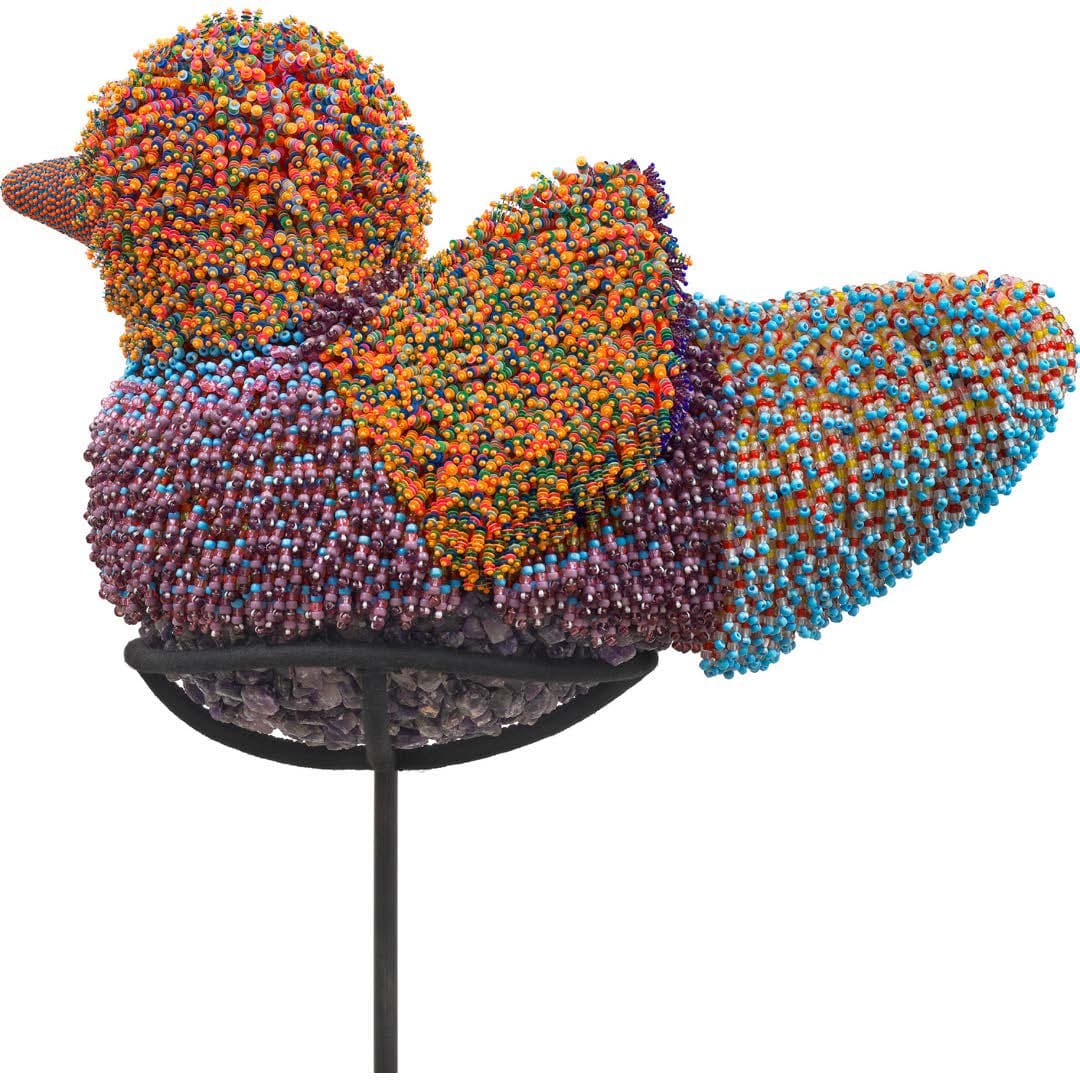
He insists upon the right of Indigenous makers to embrace heterogeneity and invent new forms without calling into question their “authenticity” based on the incorporation of non-Native patterns, materials, or styles.
Indeed, what Brazilian artists and critics of the early twentieth century famously referred to as anthropofogia (cultural cannibalism, of sorts) is intrinsic to the process of art becoming modern. Gibson's bead-encrusted bird sculptures if there is no struggle there is no progress and we are the witnesses are thus a rebuttal to the historical dismissal of such hybrid objects and artists.
A collector of Native-made beadwork of all types, Gibson applies found beadwork, purchased from websites or estate and garage sales, to sheets of painted cotton rag paper in his recent multimedia works.3These range from early twentieth-century bags created by Native makers from the Columbia River Plateau region for use within the community, incorporated into GIVE MY LIFE SOMETHING EXTRA, to medallions and belt buckles recently made in a cross-tribal style for the market, included in WE WILL BE KNOWN FOREVER BY THE TRACKS WE LEAVE.
Each work is treated lovingly and left intact in its original form, with many surrounded by three-tier halos of beadwork of Gibson's own design as he seeks to create the perfect marriage of object, text, and painting. The inclusion of these objects is a gesture of love, creating a physical, human connection to the maker and their traditions as well as a visual dialogue within the composition.
3 If you have additional information about the historical beadwork in the exhibition, especially the makers' names or tribal affiliations, contact curatorial@pam.org.
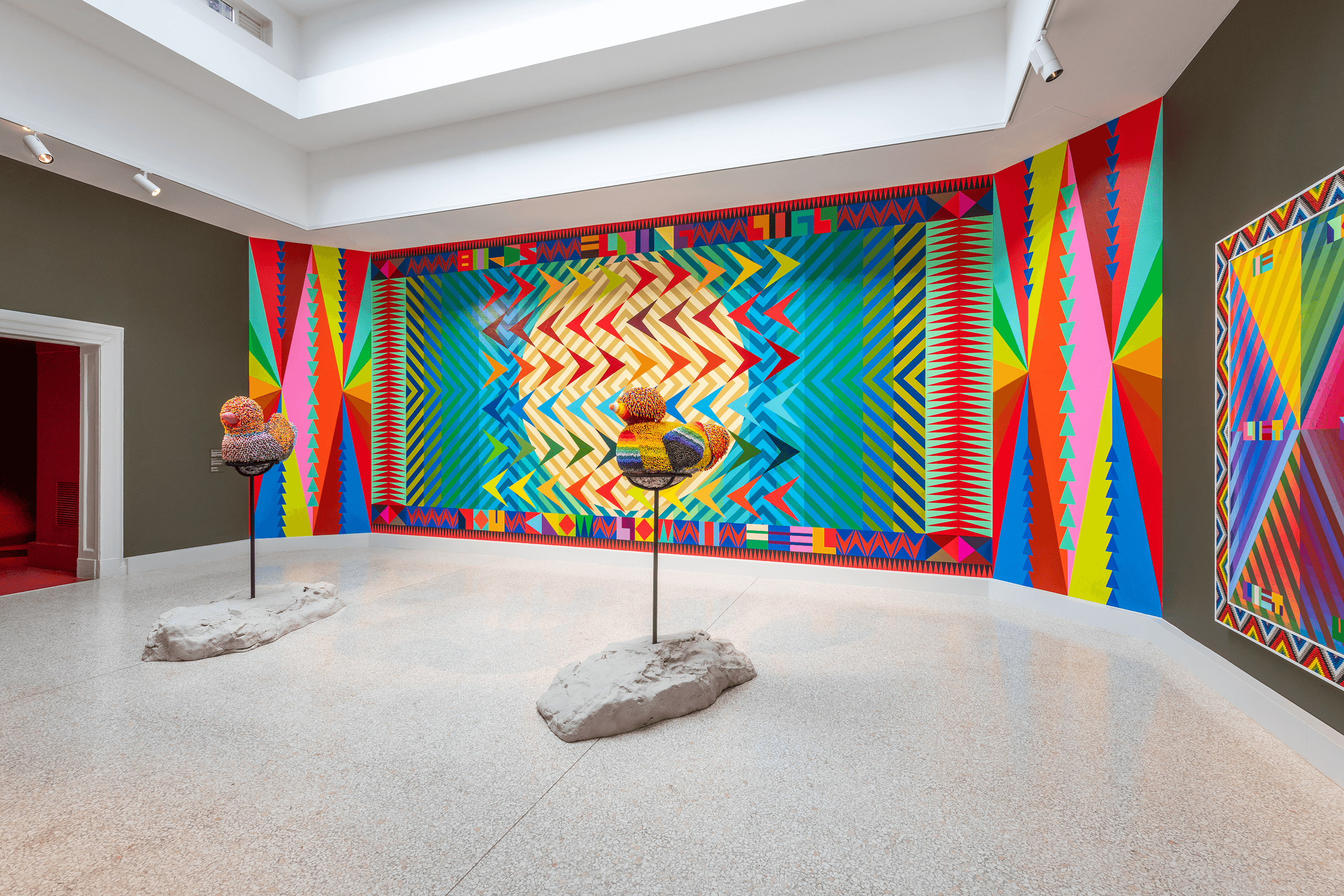
Jeffrey Gibson: the space in which to place me installed in the U.S. Pavilion of the Venice Biennale, 2024, photos by Timothy Schenck; All artwork courtesy of Jeffrey Gibson Studio
The exhibition closes with Gibson's homage to Indigenous matriarchy and the curative powers of art.
The video installation She Never Dances Alone features Sarah Ortegon HighWalking, Eastern Shoshone and Northern Arapaho, dressed in a series of her own jingle dresses and dancing to the thumping beats of The Halluci Nation, a First Nations electronic dance group. The Jingle Dance originated over a century ago, when Native American culture was suppressed, dances rooted in ceremony were outlawed, and disease continued to decimate Indigenous populations.
Today, the Jingle Dance is performed by women on the intertribal powwow circuit to call upon ancestors for strength, healing, and protection. In the video, Ortegon HighWalking multiplies exponentially, representing all Indigenous mothers, sisters, daughters, and aunties, past and present, and affirming their (and our) presence in the future.
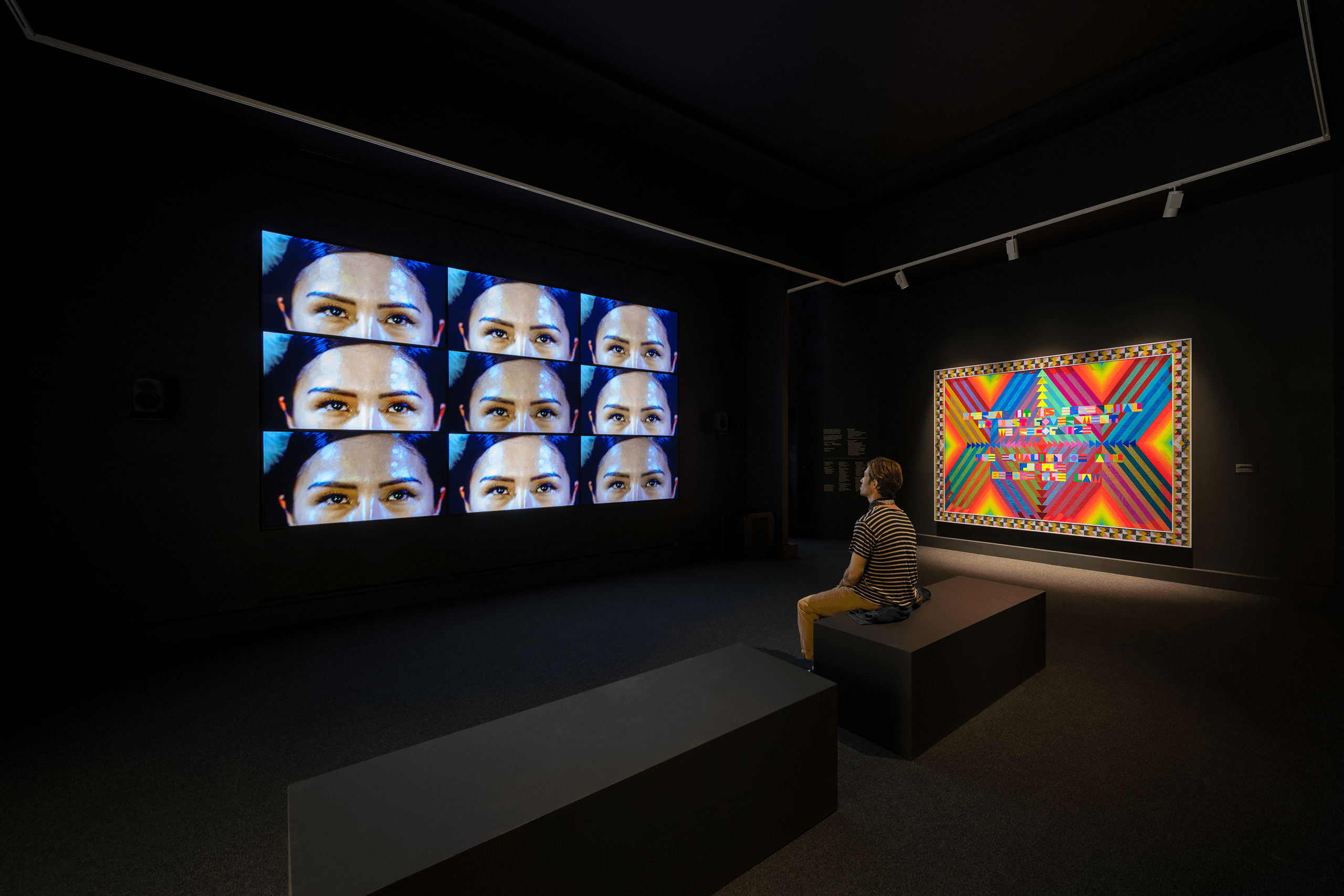
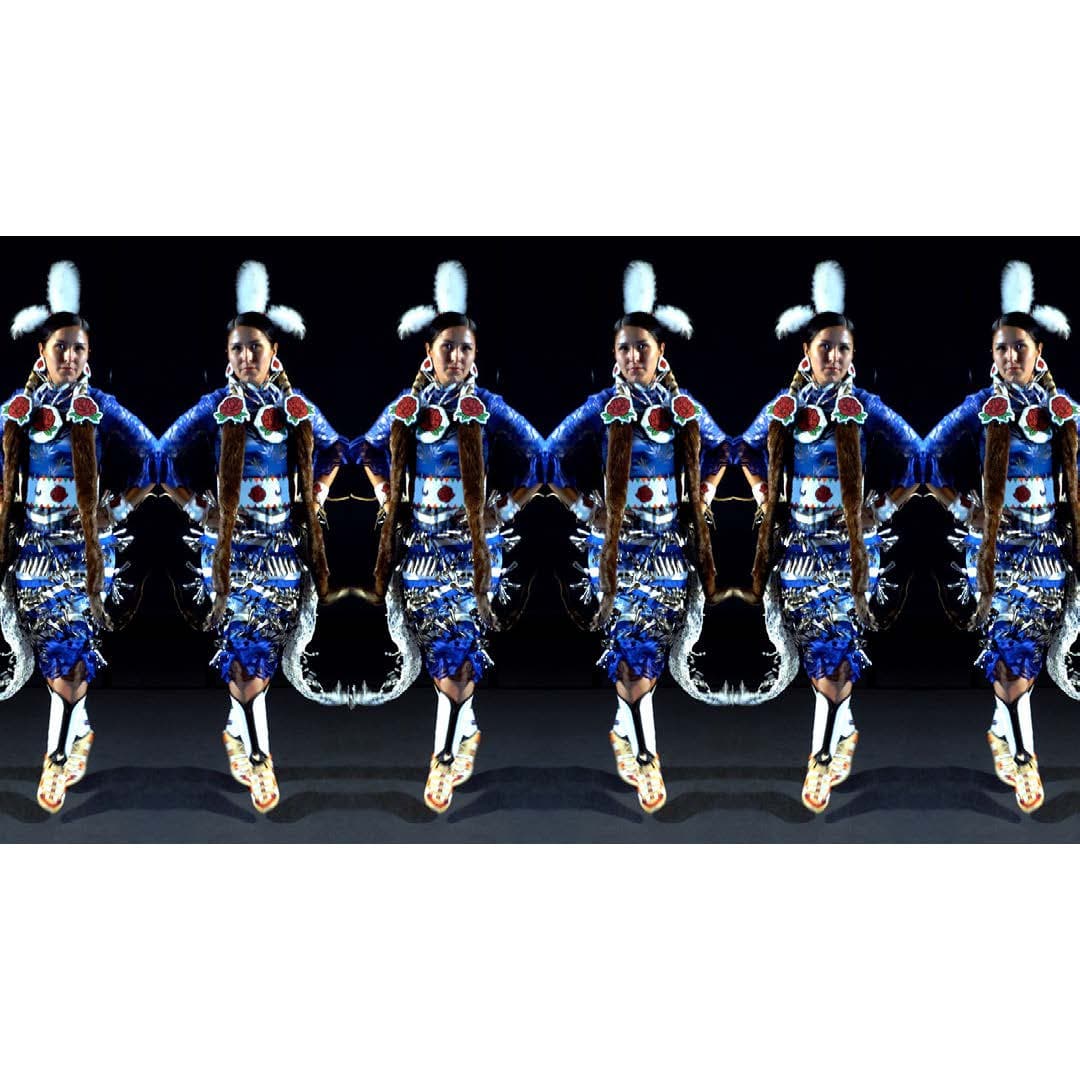
the space in which to place me embodies Gibson's belief in the healing power of art expressed through an ethos of love and acceptance.
And it reminds us that we never dance alone.
The project includes two educational partners:
Institute of American Indian Arts (Santa Fe, NM) and Bard College (Annandale-on-Hudson, NY)

Photo by Gus Powell for the New York Times
In conjunction with the presentation at the U.S. Pavilion, the Institute of American Indian Arts (Santa Fe, NM) will organize the Venice Indigenous Arts School, a series of public programs in Venice, June 10- 14, 2024. The week-long school will be conducted by the IAIA MFA in Studio Arts Program, under the direction of Mario A. Caro. Focused on developing Keywords in Indigenous Arts, its curriculum aims to continue the work of identifying a vocabulary best suited for discussing Indigenous arts—on its own terms.

Photo by Gus Powell for the New York Times
Bard College (Annandale-on-Hudson, NY), under the direction of Christian Ayne Crouch, will organize a convening focusing on the relationship of the art and culture of Indigenous North America to global histories that will take place in Venice October 26-28, 2024. Both of these partner programs focus on connecting Indigenous, Native American, and international undergraduate humanities students, graduate art students, and the public.
About the Commissioners
About the Venice Biennale
Support
Presenting Support
The Mellon Foundation
The Ford Foundation
Lead Support
John D. and Catherine T. MacArthur Foundation
Major Support
Agnes Gund
Arison Arts Foundation
Carl & Marilynn Thoma Foundation
The Hearthland Foundation
Henry Luce Foundation
Sotheby's
Terra Foundation for American Art
Generous Support
Anonymous
Becky and David Gochman
Bloomberg Philanthropies
Laurie M. Tisch Illumination Fund
Lisa Domenico Brooke
The Pollock-Krasner Foundation
The Robert Lehman Foundation
The Rockefeller Brothers Fund
Sakana Foundation
The Schmidt Family Foundation
The Teiger Foundation
Educational Partners and Program Support
Institute of American Indian Arts
Bard College
Crystal Bridges Museum of American Art
Smithsonian's National Museum of the American Indian
Essential Support
A&L Berg Foundation
David Bolger
Deborah Beckmann and Jacob Kotzubei
Dior
Elysabeth Kleinhans
The George Economou Collection
Laura Donnelley
Margaret Morgan and Wesley Phoa
Nicolas Berggruen Charitable Trust
Pamela and David Hornik
Pat and Leona Green
Regina L. Aldisert
Roberts Projects
Sasha and Edward P. Bass
Sikkema Jenkins & Co.
Stephen Friedman Gallery
Trellis Art Fund
Sustaining Support
Creative Capital Foundation
East West Bank
The James Howell Foundation
PDX Contemporary Art
Vera R. Campbell Foundation
VIA Art Fund
Additional Support
Chet Architecture
Ed Cauduro Fund of Oregon Community Foundation
The Fleischner Family Charitable Foundation
Fotene and Tom Cote
Gibert Guaring and Daniel Tobin
Miyoung Lee and Neil Simpkins
The Muriel Pollia Foundation
Sponsors include
Anonymous
Delbert Thompson
Dr. Daniel S. Berger
Judith Fried
Lauren Tank
Linda Howe
Lizbeth and George Krupp
Marshall Price
Nancy Gill
Shirley Ash
Tizziana Baldenebro and David Novgorodsky
UBS
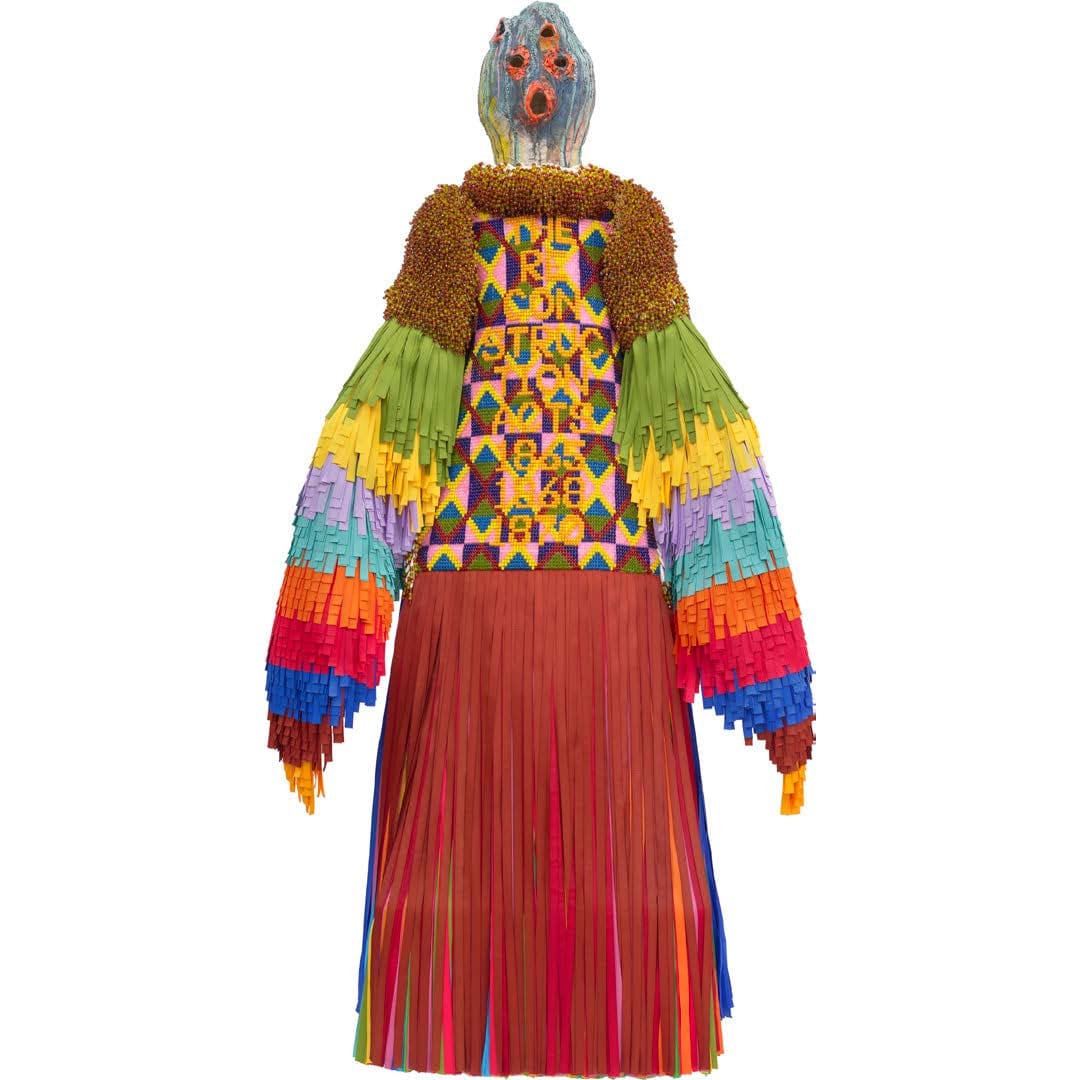
Jeffrey Gibson, The Enforcer, 2024, Ceramic, glass beads, plastic beads, nylon grosgrain ribbon, tin jingles, nylon thread, canvas, acrylic felt, cold-rolled mild steel, steel plate; 84 × 40 × 24 in. (213.4 × 101.6 × 61 cm)
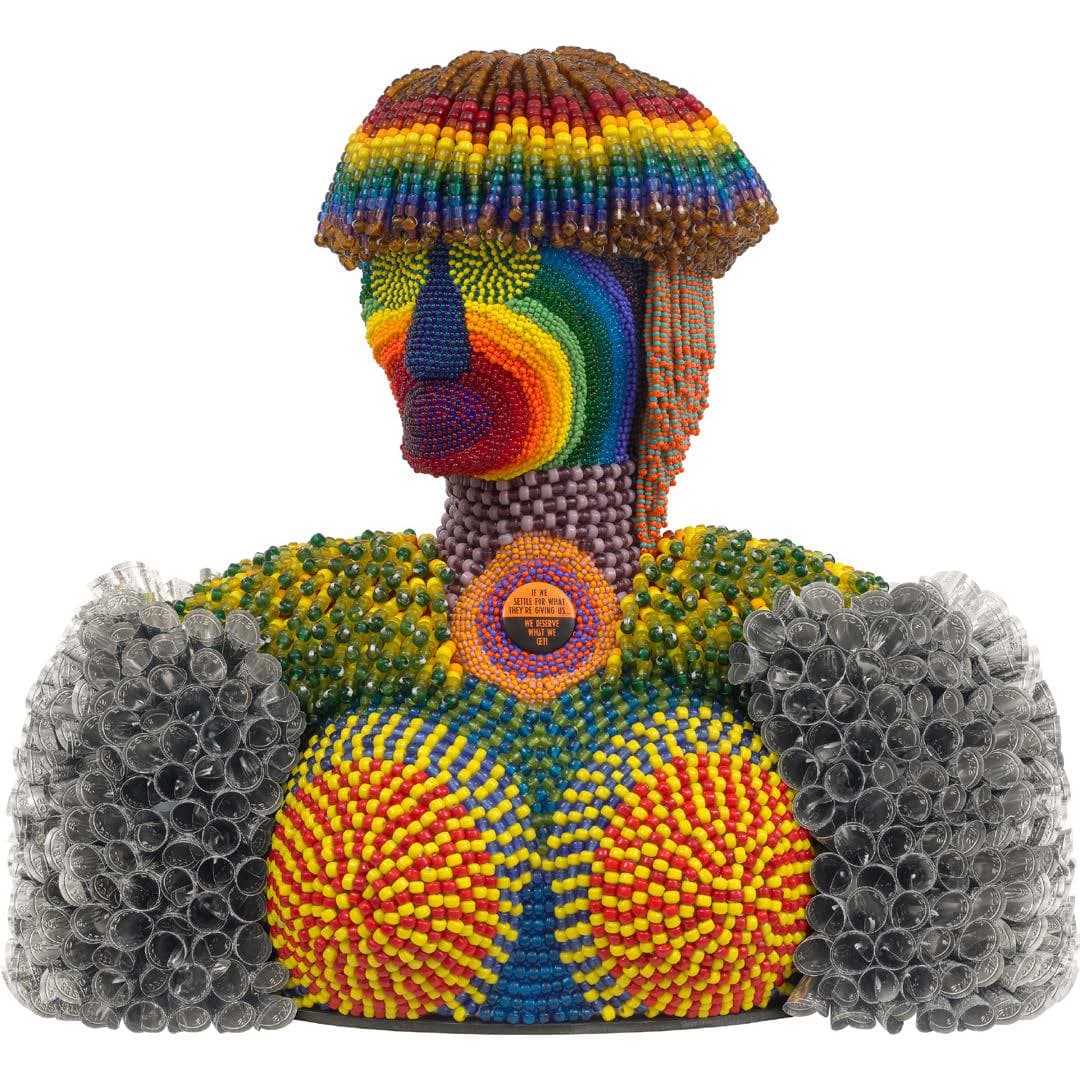
Jeffrey Gibson, Be Some Body, 2024, Glass beads, nylon thread, vintage pinback buttons, tin jingles, acrylic felt, cold-rolled mild steel, steel plate, marble base; 23 × 24 × 12 in. (58.4 × 61 × 30.5 cm)
